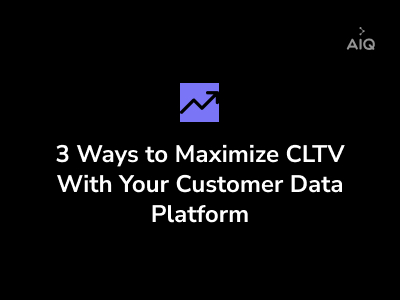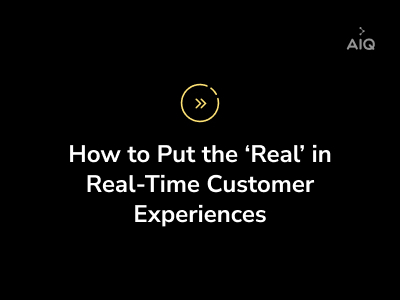3 Ways to Reduce Marketing Costs With Your Customer Data Platform
July 26, 2021Ever taken a drive cross-country? A good old-fashioned map is all you need to reach your destination.
But odds are you’re interested in more than just getting from point A to point B. You want to make good time, save on gas and avoid any wrong turns. That’s why you’ve probably traded in your paper map for a digital app. Why risk the hassle when you can find the optimal route, stay updated on traffic conditions and steer clear of potential roadblocks?
The same holds true for your marketing strategy. You don’t want to just acquire new customers, you want to win business more quickly and reduce how much it costs to do so. Fortunately, your customer data platform (CDP) is built for more than just knowing your customers — it can also help you engage them more intelligently.
Here are three ways you can use your CDP to reduce your customer acquisition cost and increase return on investment on your marketing budget.
1. Improve Audience Targeting
If your goal is winning new business, marketing to existing customers is a recipe for wasted spend. In fact, a study conducted by Forrester found that 37% of marketers waste their budget because of poor data quality. Use machine learning-powered identity resolution to unify siloed and incomplete customer records so you always know who you’re talking to — and when you shouldn’t be.
Once you have comprehensive and accurate profiles for your loyal customers, you can use them to create audience segments and suppress certain ones from specific marketing campaigns. Simply export the audience to the relevant acquisition channels from within your CDP to ensure you’re not spending your marketing budget chasing after the already-converted rather than potential customers. Pandora Media reduced customer acquisition cost by 50% in key segments by using ActionIQ to strategically suppress audiences across paid media campaigns, significantly increasing marketing ROI.
Audience suppression is also valuable if you leverage discounts as part of your marketing strategy. Dollar- or percentage-off promotions are an excellent way to entice shoppers, but not all consumers require special offers to make a purchase. Identify existing customers who make regular purchases regardless of discounts and suppress them from any discount-related messaging to optimize revenue.
2. Enhance Omnichannel Engagement
Being in multiple places at once isn’t cheap, but the cost of neglecting your omnichannel strategy is much higher. Consumers expect you to deliver consistent experiences across any and all channels where they might interact with your brand, and data shows that omnichannel marketing — such as combining email, social media and digital marketing — results in a 250% higher purchase rate than single-channel strategies that only focus on one of many marketing channels.
But delivering personalized customer experiences isn’t about catering to all consumers — it’s about serving yours. Orchestrate multi-step customer journeys for specific audience segments within your CDP to understand which marketing channels spark the most customer interest. By measuring how journeys perform across different touchpoints, you can optimize the frequency of your marketing on specific channels to double down on what works and pull back on what doesn’t.
Tracking the behaviors of prospects and customers across different channels over time has helped ActionIQ customers not only lower acquisition costs by as much as 50%, but increase repurchase rates and customer lifetime value by up to 30% and 25%, respectively.
After you understand which channels warrant the most investment, you can focus on promoting consistent purchasing cycles on them. First, calculate the order gap metric at the individual customer level within your CDP to identify customers who are outside of their regular purchasing frequency. Next, automate daily campaigns for these customers on their preferred channels. This approach has not only helped ActionIQ customers eliminate manual list selection processes, it’s also helped them reduce customer attrition by 20%.
3. Shorten Conversion Times
90% of U.S. consumers have something in common: They want personalized marketing content. But tailoring content to specific audiences isn’t enough to optimize marketing spend — you also have to know which content converts potential customers into brand loyalists.
Use customer interaction and purchase data to determine which types of content are most likely to move the needle for different audience segments, then build and operationalize a model within your CDP to target them. This way you can inform content creation and avoid expensive marketing efforts — such as batch-and-blast campaigns — that don’t drive results.
Remember that messaging is just as important as channel and format. For example, maybe your brand sells products that significantly vary in price point. Advertising big-ticket items to customers who typically only purchase sales items is not only a waste of your marketing budget, it’s a good way to annoy loyal customers with content that’s not tailored to their specific wants and needs. Instead, use your CDP to segment your audience and split customers into different groups based on their purchasing behaviors. Doing this can help cut marketing costs and ensure customer retention rates stay high. Customers who respond more favorably to sales will receive content highlighting limited-time promotions. Customers who have a history of buying high-end products will receive more brand-focused messaging. And customers who fall into both camps will receive a mixture.
This will help you focus your spending and boost engagement simultaneously. One ActionIQ customer who adopted this strategy experienced a 20% increase in engagement rate over email alone.
Driving sales will always be a priority for your business, but it pays to keep marketing costs top of mind while you do it. If you want to spend smarter and maximize revenue, make sure you have the customer data you need to identify opportunities — and the necessary marketing tools to transform those insights into action. Start by equipping your business users with a CDP that allows them to orchestrate customer experiences across all relevant channels and at scale without complicated technical knowledge.
Learn More
Download our 2021 CDP Market Guide to learn more about CDPs, how to reduce marketing costs and the role technology plays in helping you reduce overall business costs to increase ROI.
This post first appeared on the ActionIQ blog. To see the full article, click here.


